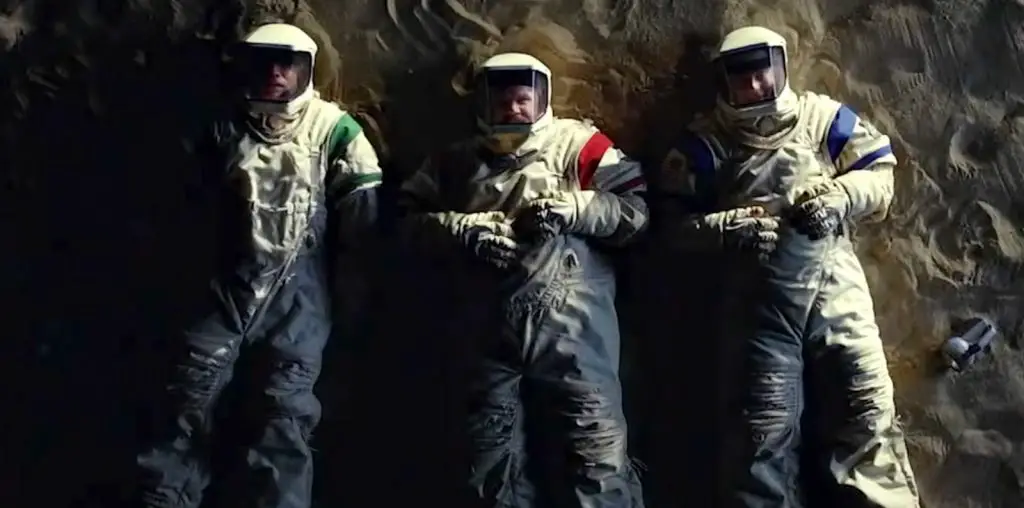
A year after world premiering at SXSW, the Australian film “Predestination” has warped into a few theaters here in the U.S., in what I suspect will be a short, small (one theater in the Washington, DC market) commercial bow before heading to the world of VOD. It’s a stylish, mind-bending, sci-fi noir thriller starring Ethan Hawke (who starred in “Daybreakers”(2009), a spiffy sci-fi-horror zombie flick from the same directors, the identical twins Michael and Peter Spierig). Based on the 1959 short story “All You Zombies” by Robert A. Heinlein, which he wrote in one day in July 1958, the Spierigs have stretched it out to feature length (shot in Melbourne over 32 days in early 2013) with some difficult plot structure to conquer, although the topic (no, not the walking dead) of time travel and self identity is, well, timeless. It chronicles a series of events that occur between 1945 and 1993 surrounding a criminal known as the “Fizzle” bomber—the name is based on the electro-magnetic detonation device being used—and the efforts by the Temporal Bureau to capture the perpetrator. One of the explosions, in 1975, leveled 10 square blocks in New York City, leaving over 11,000 dead. For the record, time travel was invented in 1981.
The chase is assigned to an unnamed agent played by Hawke, who is recovering from a close encounter with the elusive terrorist. Disfigured in a bomb blast, his surgeries leave him a different person (reminiscent of Frankenstein’s monster when the bandages are first removed), and his mental state has been diagnosed as depressive and borderline psychotic, the result of too many time jumps. Yet, he is still eager for his final mission, before being decommissioned.
At times, the film takes on a bleak Terry Gilliam atmosphere, with dashes of “Blade Runner” tossed in. The technical device used for time travel is an old school violin case with no moving parts and a set of 13 tarnished alpha-numeric date/time tumblers (huh, no latitude/longitude settings?), and one square white push button; the bomb containment suitcase is somewhat more futuristic. He sports an art deco, non-digital watch with old fashion flourishes (the first date it shows is actually Ethan Hawke’s birthdate) and two standard issue six shooters. Weird blend.
One longish sequence takes place in the earthy color palette of 1970 New York City, at a bar called Pop’s Place, where Hawke has assumed the role of the bartender, listening to a story told by one of the chain-smoking patrons (Sarah Snook, looking strangely like Leonardo DiCaprio), a rather androgynous character writing under the pen name The Unmarried Mother. During this rather heavy dialogued sequence come flashbacks, first to a desaturated green 1945, when an newborn girl is delivered to the steps of the Cleveland Orphanage by an unknown male. Jane, as she is called, grows into 5- and 10-year-old versions of an outcast introvert (“something was different about me… sex confused me”) forced to fend for herself. And then into a young, pretty redhead recruited by a mysterious Mr. Robertson (Noah Taylor) into an organization known as SpaceCorp, because of her grasp of science and mathematics. The decor in this segment of the film is a 1960s World of Tomorrow look with the attire blending a Hester Prynne hat with a Pan Am flight stewardess frock, but with a darker blue hue.
There are some problems in the script. Jane’s retelling of her SpaceCorp expulsion differs from what we’re seeing on screen. Whose story is this? I didn’t think the bar-side 40 minute listen-to-my-story approach between the two leads worked effectively.
Ethan Hawke is decent, but Sarah Snook (who starred in last year’s horror thriller “Jessabelle”) is quite strong in a role that incorporates dual guises. It’s similar to how Tatiana Maslany handles her multiple characters on TV’s “Orphan Black,” although Snook doesn’t really play opposite any of her incarnations, with one key exception. Costuming (by Wendy Cork) and makeup (Tess Natoli) help separate the Jane character as it transforms from one adorable personality to John, a scarred, haggard, and slightly peach-fuzzed one. Cue the pee stream into an open toilet.
The color and production scheme are top notch, with cinematography by Ben Nott (who shot “Daybreakers”) and production design by Matthew Putland (having worked on all three of the Spierig features). It takes nearly an hour before the talking/narration really stops and the effects chime in with the first temporal wake. Some viewers might have expected some of these time disruption shenanigans earlier (characters disappearing in one location as the sound effects increase and nearby set pieces such as bottles, papers, and light bulbs crash, flutter, and pop about in an agitated state. Reverse for the new “time” as actors collapse and gasp for air.). As time shifting police movies go (“Time Cop,” “Looper,” “Minority Report“), “Predestination” takes a noirish approach, as a low key mood piece with characters who will cause fits for any genealogist trying to plot their family tree. The Spierig Brothers offer up food for thought, with little spice, and give new meaning to the phrase “You are your own worst enemy” in their latest effort. It’s not all that logical (too many rabbit holes) and at least one character might be guilty of temporal suicide. Where are the real time cops when you need them? An ambitious, slow-to-reveal, and overly meditative failure.
